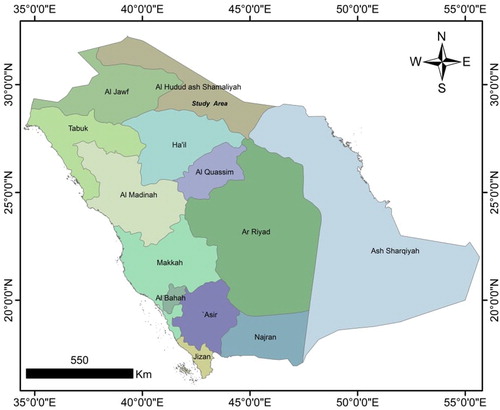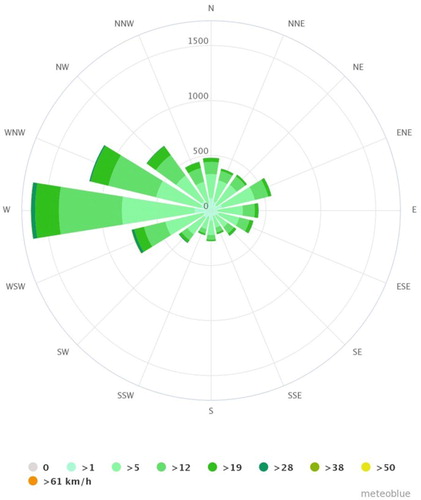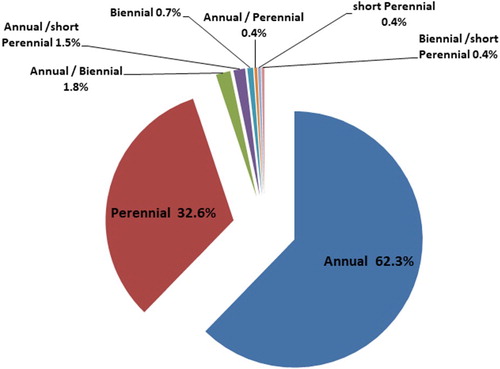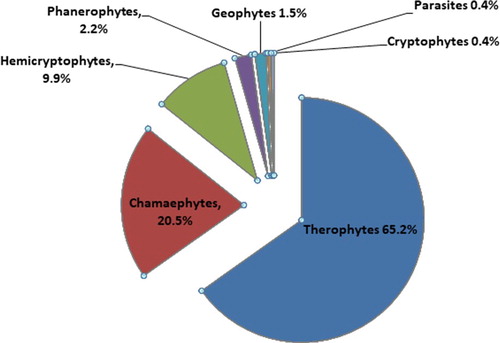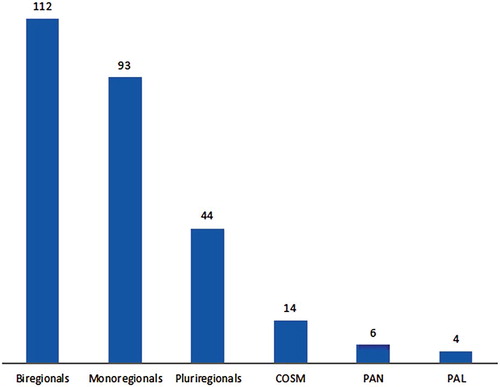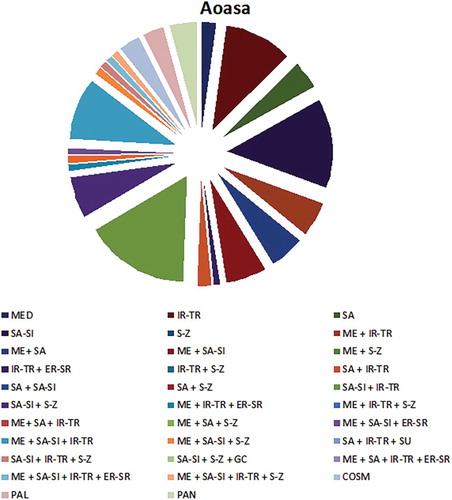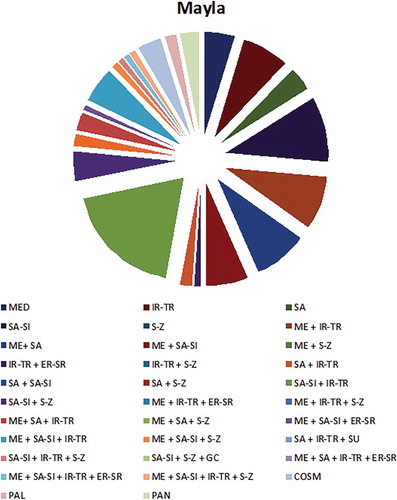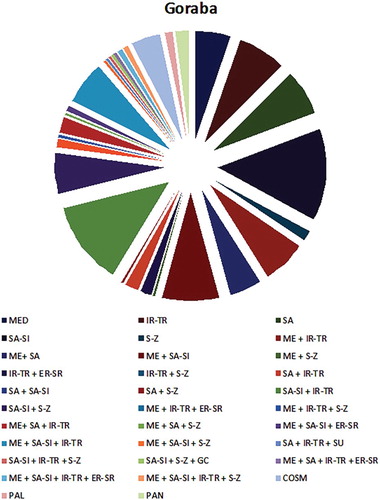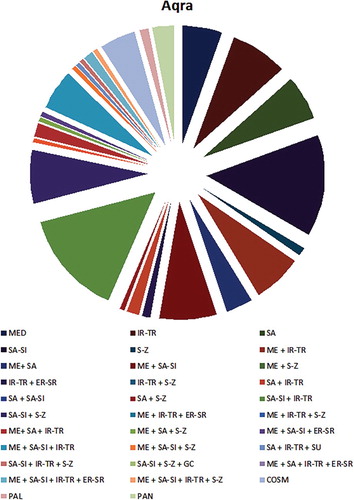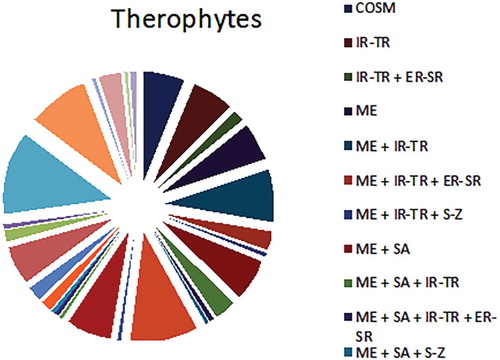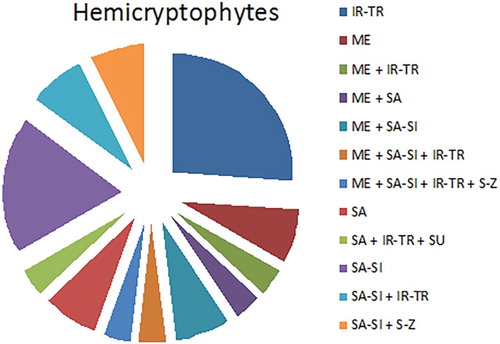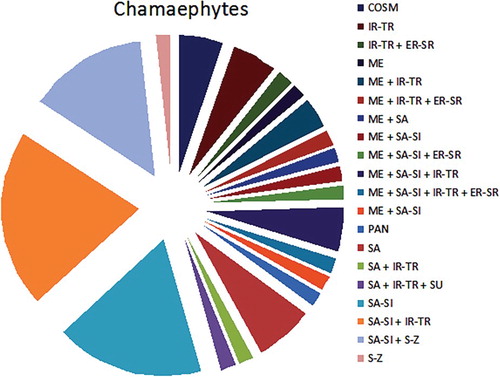ABSTRACT
One of the most countries containing which have biologically diverse, is Saudi Arabia. Among the plant species recorded in Saudi Arabia, about 30% are rare and around 18 plant species are thought to have been disappeared locally. The study aims to provide the researchers in various scientific fields with a list of wild plants available in the examined region. The current work focused on an analysis of life forms, life span and chorotypes in four fenced areas (Aoasa, Mayla, Goraba and Aqra) of wadi Ar'ar. A bout of 273 taxa belonging to 35 families and 169 genera of vascular plants were recorded. Phytogeographically, the listed species were classified into three groups; monoregional, biregional and pluriregional. Twenty four species were listed as cosmopolitan, paleotropical or pantropical. One important step in preserving our wild plants is to expand knowledge of vegetation and find solutions to preserve the environment and species from extinction.
1. Introduction
Saudi Arabia is a wide dry desert with a size of approximately 2,250,000 km2 occupying the greatest section of the Arabian Peninsula. So, xerophytic flora is a significant visibility of plant life in this area [Citation1]. Saudi Arabia located between longitudes 34°40′E–55°45′E and latitude 15°45′N–34°35′N [Citation2,Citation3].
The geological history of this region indicates that this region shares with the flora of the west Africa, the southeast & northeast Asia and the north & northwest Mediterranean. The vegetation of Saudi Arabia belongs to Saharo-Sindian phytogeographical region [Citation4].
There are many previous studies that have been described the Flora of Saudi Arabia [Citation5–8]. Furthermore, Collenette [Citation9] illustrated the Flora of Saudi Arabia. Osman et al. [Citation10] were described the flora in wadi Ar'ar as well as, vegetation analysis in this area. Flora of Saudi Arabia includes about 2243 plant species. Approximately 656 species subsist in small populations while, 500 species are coexisting in limited areas. Moreover, around 100 species have been recorded as endangered [Citation11].
There are no permanent streams and lakes in Saudi Arabia; however, it contains a number of Wadis in different parts of the country [Citation12]. The vegetation in the Wadis is variable from year to year. It depends on several environmental factors as physiographic factors, geographical location, moisture content and human activities [Citation13–16].
Food shortage and Lack of available resources are among the most important problems facing Saudi Arabia. Therefore, Saudi Arabia is working to adopt new styles in various fields, especially the agricultural field [Citation17]. Vegetation structure is the greatest significant agents influencing pasture production [Citation18], in addition to, the anthropogenic effects (wood cutting, overgrazing and over cultivation) [Citation19].
Wherefore, Saudi Arabia in 1985 had established the Saudi Wild life Commission to preserve wild life and restore ecological balance. In this time, the Saudi Wild life Commission operates 15 fenced areas [Citation20].
The Northern Border Region is one of the greatest essential regions of Saudi Arabia because it contains many fenced areas as (Aoasa, Mayla, Goraba and Aqra). This work aims to assess the floristic diversity in fenced areas of Wadi Ar'arregion. Furthermore, the life forms, vegetation types and chorotypes of the gathering species taken into seeing.
2. Materials and methods
Wadi Ar'ar is existing in the Northern Border region of Saudi Arabia in an area of 9500 km2 (longitudes 41.04°E and latitude 30.98°N, about 555 m above sea level) (Figure ). Data obtained from website https://www.meteoblue.com/en/weather/forecast/modelclimate/arar_saudi-arabia_108512 from (1987–2018) showed; The average lower air temperature differs from 2°C during January to 23°C during August and July, meanwhile average upper air temperature differs from 16°C during January to 42°C during August (Figure ). The maximum values of rainfall (Precipitation) were recorded during March (6 mm), on the other hand, there is no rainfall (Precipitation) were recorded during June, July, August and September (Figure ). The direction of the prevailing winds throughout the year is west winds (Figure ). Using ESRI Arc GIS ver. 10.5. to create a map showing the study area.
Figure 2. Klima diagram showing average annual temperature range and precipitation of Wadi Ar’ar (1987–2017).
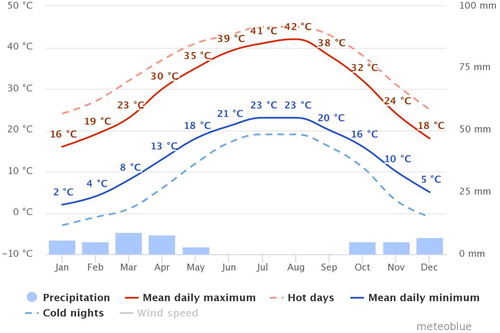
Survey of four fenced Areas of Wadi Ar'ar-Northern Border region was conducted between March 2014 and March 2018 to represent the flora during different seasons. About 240 positions distributed across all of the major zones of the study area were selected. Plant species registered after complete identification according to Collenette [Citation9], Cope [Citation21], Migahid [Citation6], Chaudhary [Citation22], Täckholm [Citation23] and Boulos [Citation24–28]. Herbarium specimens were saved in the herbarium of the Biology Department, Science College, Northen Border University. Vegetation types named according to http://www.theplantlist.org/. Categories of Life forms were identified after Raunkiaer [Citation29], as modified by Govaerts et al. [Citation30]. Phytogeographical affinities made to determine the listed species in world geographical groups according to Eig [Citation31].
3. Results
A whole of 273 taxa related to 35 families and 169 genera were recorded in Wadi Ar'ar fenced Areas (Table ). Asteraceae (67 species = 24.5%), Poaceae (30 species = 11%), Fabaceae (28 species = 10.3%) and Brassicaceae (25 species = 9.2%) were the most common families. Chenopodiaceae, Caryophyllaceae, Boraginaceae and Apiaceae were represented by 6.2% (17 species), 4.4% (12 species), 4% (11 species) and 3.7% (10 species), respectively. Both Euphorbiaceae and Plantaginaceae were represented by 2.6% (7 species each), while Lamiaceae was represented by 2.2% (6 species). Amaranthaceae, Papaveraceae, Polygonaceae and Zygophyllaceae were represented by 1.8% (5 species each). Geraniaceae was represented by 1.5% (4 species), while Convolvulaceae and Solanaceaewere represented by 1.1% (3 species each). Six families were represented by 2 species, meanwhile 11 families were represented by one species (Table , Figure ).
Figure 4. Graphical representation of angiosperm families according to the numbers of the species collected from Ar’ar–Northern Border region of Saudi Arabia.
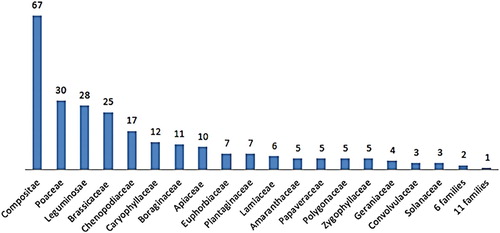
Table 1. A list of the species recorded in Wadi Ar'ar fenced areas.
In respect to vegetation type, the majority of the registered species in this survey were Annuals with 170 of the total recorded species (62.3%), followed by the perennials with 89 species (32.6%). Annual / Biennial was represented by 5 species (1.8%), Annual / Short perennial was represented by 4 species (1.5%) and Biennial was represented by 2 species (0.7%). Both Annual / Perennial, Short perennial and Biennial / Short perennial were showed by one species each (0.4%) (Table , Figure ).
Table 2. Tubular summary showing the Vegetation diversity, Vegetation type and Life form of fenced Areas (Abbreviations according to Table ).
The majority vegetation type of the recorded species in Aoasa, Mayla, Goraba and Aqra was Annuals with 58 (61%), 71 (67%), 75 (65%), 99 (60%) of the total listed species respectively, followed by the Perennials with 33 (35%), 30 (28%), 75 (30%), 56 (34%) species respectively. For more details, see Table .
According to the classification of Raunkiaer [Citation29] as modified by Govaerts et al. [Citation30], seven life forms were recorded, the most numerous life form and were therophytes (65.2% = 178 species), followed by Chamaephytes (56 species = 20.5%), Hemicryptophytes (27 species = 9.9%), Phanerophytes (6 species = 2.2%). Four species were Geophytes (Convolvulus arvensis, Erodium crassifolium, Centropodia forskaolii and Cynodon dactylon), both Cryptophytes and Parasites were showed by one species (Reichardia tingitana and Cistanche phelypaea, respectively) (Tables and , Figure ).
Therophytes was the most abundant life form in Aoasa, Mayla, Goraba and Aqra regions, with 60 (63%), 71 (67%), 168 (68%), 103 (62%) species respectively, followed by Chamaephytes with 22 (23%), 22 (21%), 46 (19%), 38 (23%) species respectively, and Hemicryptophytes with 7 (8%), 10 (9%), 25 (10%), 18 (11%) species respectively. For more details, see Table .
Phytogeographically, the listed species were classified into three groups; bioregional, monoregional, or pluriregional [Citation31]. A bout of 93 species (34.1%) were monoregional. monoregional species fall under five affinities; Saharo-Sindian (37 species = 13.5%), Irano-Turanian (21 species = 7.7%), Saharo-Arabian (18 species = 6.6%), Mediterranean (13 species = 4.8%) and Sudano-Zambesian (4 species = 1.5%) (Tables and , Figure ).
In Aoasa, Mayla, Goraba and Aqra, a total of 29 species (30.5%), 28 species (26.4%), 86 species (34.5%) and 57 species (34.6%) respectively were monoregional. Monoregional species fall under five affinities; Saharo-Sindian, Irano-Turanian, Saharo-Arabian, Mediterranean and Sudano-Zambesian. For more details, see Table , Figures –.
Table 3. The number of recorded species belonging to the main floristic categories and their relevant percentage (%) abbreviations are as in Table .
Biregional geoelements were represented by 112 species comprising 41% of recorded species. Irano-Turanian-Saharo-Sindian represented by 31 species (11.4%). Mediterranean-Saharo-Sindian regions represneted by 8% = 22 species. Both Mediterranean-Irano-Turanian and Saharo-Sindian-Sudano-Zambesian represented by 6.2% = 17 species. Mediterranean-Saharo-Arabian regions represented by 4.8% = 13 species. Irano-Turanian-Saharo-Arabian regions represented by 1.8% = 5 species. Irano-Turanian-Euro-Siberian regions represented by 1.5% = 4 species. For more details, see Tables and , Figure .
In Aoasa, Mayla, Goraba and Aqra, biregional geoelements were represented by 40, 53, 106, 72 species, respectively. For more details, see Table , Figures –.
Pluriregional geoelements were represented by 16.1% = 44 species. Mediterranean-Irano-Turanian-Saharo-Sindian were represented by 6.5% = 18 species. Both Mediterranean-Irano-Turanian-Euro-Siberian and Mediterranean-Irano-Turanian-Saharo-Arabian represented by 2.2% = 6 species. Four phytochoria, Mediterranean-Euro-Siberian-Saharo-Sindian, Mediterranean-Irano-Turanian-Euro-Siberian-Saharo-Sindian, Irano-Turanian-Saharo-Arabian-Sudanian and Mediterranean-Irano-Turanian-Saharo-Sindian-Sudano-Zambesian were represented by 0.7% = 2 species. For more details, see Tables and , Figure .
The remaining 8.8% = 24 species were differentiated as follows: 5.1% = 14 species were cosmopolitan, followed by 2.2% = 6 species were pantropicaland and 1.5% = 4 species were palaeotropical (Tables and , Figure ).
In Aoasa, Mayla, Goraba and Aqra, pluriregional geoelements were represented by 16 (16.8%), 16 (15%), 38 (15.3%) and 21 (12.7%) of the recorded species respectively. For more details, see Table , Figures –.
The remaining species in Aoasa, Mayla, Goraba and Aqra were 10 (10.6%), 9 (8.6%), 19 (7.6%) and 15 (9.1%) respectively. For more details, see Table , Figures –.
The relation between phytogeographical affinities and life forms showed that, Therophytes belonging to Saharo- Sindian represented by 12.4% = 22 species, Mediterranean- Saharo- Sindian represented by 10.2% = 18 species, Saharo- Sindian- Irano- Turanian regions represented by 9% =16 species, Mediterranean- Irano- Turanian represented by 7.9% = 14 species, Mediterranean- Saharo- Sindian- Irano- Turanian represented by 6.8% = 12 species, cosmopolitan, Irano- Turanian and Mediterranean- Saharo- Arabian represented by 6.2% = 11 species, Mediterranean and Saharo- Arabian represented by 5.6% = 10 species, Mediterranean- Irano- Turanian- Saharo- Arabian and Saharo- Sindian- Sudano- Zambesian reoresented by 3.4% = 6 species, Mediterranean- Irano- Turanian- Euro- Siberian represented by 2.8% = 5 species, pantropical represented by 2.3% = 4 species, Irano- Turanian- Euro- Siberian, palaeotropical and Saharo- Arabian- Irano- Turanian represented by 1.7% = 3 species, Sudano- Zambesian represented by 1.1% = 2 species, Mediterranean- Irano- Turanian- Sudano- Zambesian, Mediterranean- Irano- Turanian- Euro- Siberian- Saharo- Arabian, Mediterranean- Saharo- Arabian- Sudano- Zambesian, Mediterranean- Saharo- Sindian- Euro- Siberian, Mediterranean- Saharo- Sindian- Irano- Turanian- Euro- Siberian, Mediterranean- Saharo- Sindian- Sudano- Zambesian, Mediterranean- Sudano- Zambesian, Saharo- Arabian- Sudano- Zambesian, Saharo- Sindian- Irano- Turanian- Sudano- Zambesian and Saharo- Sindian- Sudano- Zambesian- Guineo- Congolian represented by 0.6% = one species (Figure ).
Phanerophytes belonging to all regions (Mediterranean- Irano- Turanian- Saharo- Sindian, Sudano- Zambesian, Saharo- Arabian- Sudano- Zambesian, Saharo- Arabian, Saharo- Sindian- Irano- Turanian and Saharo- Sindian- Sudano- Zambesian) represented by 16.7% = one species.
Hemicryptophytes belonging to; Irano- Turanian represented by 25.9% = 7 species, Saharo- Sindian regions represented by 18.5% = 5 species, Mediterranean- Saharo- Sindian- Sudano- Zambesian, Mediterranean- Saharo- Sindian, Saharo- Arabian and Irano- Turanian- Saharo- Sindian were represented by 7.4% = 2 species, Mediterranean- Irano- Turanian- Saharo- Sindian- Sudano- Zambesian, Mediterranean- Irano- Turanian, Mediterranean- Saharo- Arabian, Mediterranean- Irano- Turanian- Saharo- Sindian and Irano- Turanian- Saharo- Arabian- Sudanian regions were represented by 3.7% = one species (Figure ).
Geophytes belonging to; Palaeotropical, Saharo- Arabian, Pantropical and Irano- Turanian- Saharo- Arabian regions represented by 25% = one species for each.
Chamaephytes belonging to; Saharo- Sindian- Irano- Turanian- Euro- Siberian represented by 21.1% = 12 species, Saharo- Sindian represented by 17.5% = 10 species, Saharo- Sindian- Sudano- Zambesian represented by 14% = 8 species, Saharo- Arabian represented by 7% = 4 species, cosmopolitan, Irano- Turanian and Sindian- Irano- Turanian represented by 5.3% = 3 species, Mediterranean- Irano- Turanian regions represented by 3.5%=2 species, Irano- Turanian- Euro- Siberian, Mediterranean, Mediterranean- Irano- Turanian- Euro- Siberian, Mediterranean- Saharo- Arabian, Mediterranean- Saharo- Sindian, Mediterranean- Saharo- Sindian- Euro- Siberian, Mediterranean- Saharo- Sindian- Irano- Turanian- Euro- Siberian, Mediterranean- Saharo- Sindian, pantropical, Saharo- Arabian- Irano- Turanian, Saharo- Arabian- Irano- Turanian- Sudanian and Sudano- Zambesian represented by 1.8% = one species (Figure ).
Parasites and Cryptophytes represented by one species belonging to the Mediterranean-Irano-Turanian-Saharo-Sindian-Sudano-Zambesian and Mediterranean-Irano-Turanian- Saharo-Sindian regions respectively.
4. Discussion
The current study focused on the description of flora in four fenced Areas (Aoasa, Mayla, Goraba and Aqra) of Wadi Ar'ar. A total of 273 taxa belonging to 35 families and 169 genera were recorded. The major families in terms of number of species were Asteraceae, Poaceae and Fabaceae. Those outcomes were in conformity with Osman et al. [Citation10], who mentioned Asteraceae, Poaceae and Fabaceae were the widely common families in Wadi Ar'ar. Also, those outcomes were largely consistent with many investigations achieved in many habitats in Saudi Arabia [Citation32–34]. Farrag [Citation32] mentionedAsteraceaewas the most common family in their studies. In addition to, Al-Turki and Al-Qlayan [Citation35]; El-Ghanem et al. [Citation36]; Alatar et al. [Citation12] and Abdel Khalik et al. [Citation37] mentioned Poaceae and Fabaceae were the most common families in their studies. It is worth mentioning that Poaceae, Fabaceae and Asteraceae comprise the major bulk of Flora in Saudi Arabia [Citation9,Citation38]. Poaceae is also the largest family scattered in the world Flora [Citation39]. In the present study six families represented by 2 species, while 11 families represented by a single species. One of the salient features of the plant composition of Saudi Arabia's Flora is that a few families were of plant importance as in most subtropical and tropical deserts and many plant families were represented by a single or two species [Citation40]. This may be due to the fact that a few number of plants were endure harsh environments in these areas. Meanwhile, other plants could not survive in these difficult conditions.
In regard to life span, the plurality of the registered species in this research were Annuals with 170 species (62.3% of the total recorded species). Those outcomes were in conformity with Shaltout et al. [Citation41] & Al-Rowaily et al. [Citation42], who mentioned that, the main components of vegetation type in Saudi Arabia were annual plants.
Plants life form distribution that grow in dry areas is widely linked to landform and topography [Citation43,Citation44]. In this study the most dominant life form was Therophytes (65.2%). This may be due to many factors such as hot, dry climate, animal interference and human influences. These results agree with many previous studies conducted in different desert habitats in Saudi Arabia [Citation9,Citation10,Citation12,Citation15,Citation22,Citation35–37,Citation40,Citation45–48]. Therophytes was the dominant life form in an arid desert region because of dry climate, overgrazing [Citation49,Citation50]. Moreover, the Therophytes high percentage was too credited to human activities [Citation51].
Phytogeographically, the registered species were classified into three groups; monoregional, biregional or pluriregional. A total of 93 species representing 34.1% of the entire number of listed species were monoregional of several affinities. The highest monoregional Phytochorion was Saharo-Sindian (37 species). Biregional geoelements were represented by 112 species forming 41% of recorded species and the highest biregional phytochorion was Irano-Turanian-Saharo-Sindian region represented by 31 species. Pluriregional geoelements were represented by 44 (16.1%) of registered species. The highest Pluriregional phytochorion was Mediterranean-Irano-Turanian-Saharo-Sindian region represented by 18 species. The remaining 24 species were divided as follows: 4 Palaeotropical, 6 Pantropical and 14 Cosmopolitan. These outcomes were in conformity with Osman et al. [Citation10]. Danin & Plitman [Citation52] and Abd El-Ghani & Amer [Citation53] referred to Sudano-Zambezian and Saharo-Arabian phytochoria decline moving north also were replaced by Irano-Turanian and Mediterranean phytochoria. This may be due to several reasons, as Sudano-Zambezian and Saharo-Arabian plants were good indicators of desert habitats, on the other hand Mediterranean species point to extra mesic habitats.
5. Conclusion
The studied, fenced areas appeared relatively high floristic diversity as a result of their protection from overgrazing. The decline in the species number in such area in comparison to other areas in Saudi Arabia is attributed to the intense human effect (overgrazing, wood cutting and development). Thus, it is recommended that additional ecological studies must be accomplished to investigate the impact of environmental and geographical variables on the plant diversity and community in this significant area. As well advised that preservation plans should be begun at once to keep the plant diversity in this hotspot.
6. Significance statement
This study highlights the importance of preserving the natural resources, which Saudi Arabia is rich in, particularly wild plants that regarded as a vital component of Saudi Arabia's natural wealth, through the enactment of laws and regulations to keep them from extinction. This study helps researchers to know the vegetation of the study area and reveal rare and threatened plants that many researchers were not able to explore.
Alternanthera sessilis (L.) R.Br. ex DC. (Medicinal plant) … … . Amaranthaceae
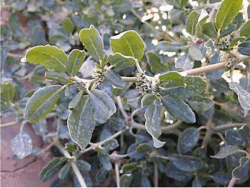
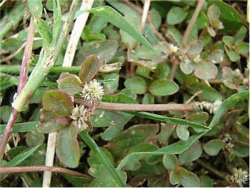
Achillea fragrantissima (Forssk.) Sch.Bip. (Medicinal plant) … … … . Asteraceae

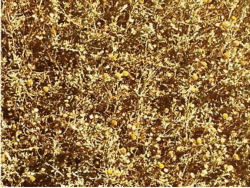
Artemisia scoparia Waldst. & Kitam. (Medicinal plant) … … … … … . Asteraceae
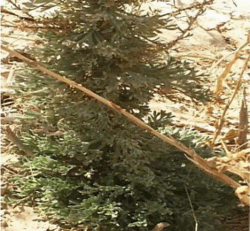
Calendula tripterocarpa Rupr. (Medicinal plant) … … … … … . Asteraceae
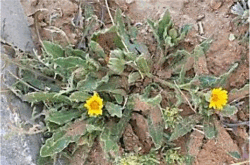
Launaea capitata (Spreng.) Dandy (Medicinal plant) … … … … … . Asteraceae
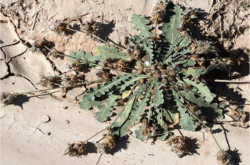
Launaea procumbens (Roxb.) Ramayya & Rajagopal (Medicinal plant) … … . Asteraceae
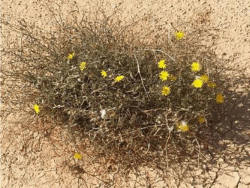
Pulicaria undulata (L.) C.A.Mey. (=Pulicaria crispa (Forssk.) Oliv. (Medicinal plant) Asteraceae
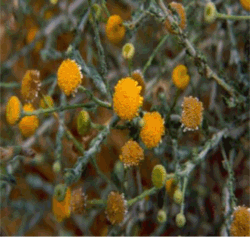
Senecio desfontainei Druce (Medicinal plant) Asteraceae
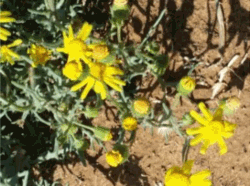
Brassica tournefortii Gouan (Medicinal plant) Brassicaceae
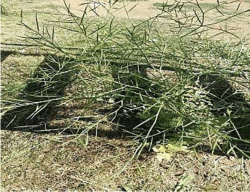
Farsetia aegyptia Turra (Medicinal plant) Brassicaceae
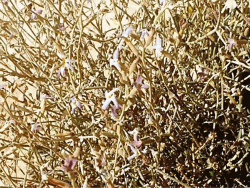
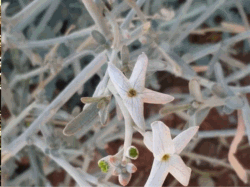
Paronychia arabica (L.) DC. (Medicinal plant) Caryophyllaceae
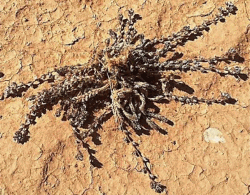
Bassia muricata (L.) Asch. (Medicinal plant) Chenopodiaceae
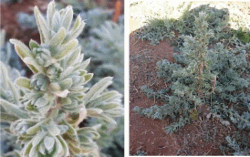
Salsola cyclophylla Baker (economic plant) … … … … ..Chenopodiaceae
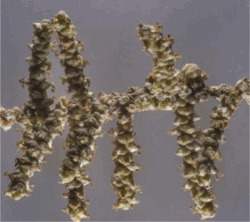
Salsola imbricata Forssk. (Medicinal plant) Chenopodiaceae
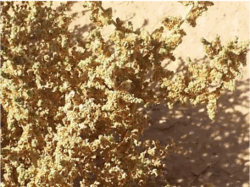
Cleome amblyocarpa Barratte & Murb. (Medicinal plant) Cleomaceae
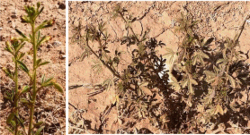
Astragalus asterias Steven (Medicinal plant) Fabaceae

Astragalus palaestinus Eig (Medicinal plant) Fabaceae

Astragalus schimperi Boiss. (Medicinal plant) Fabaceae
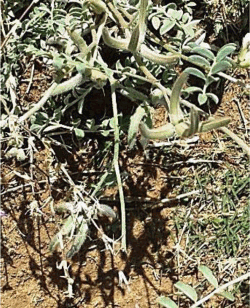
Astragalus spinosus (Forssk.) Muschl. (Medicinal plant) Fabaceae

Erodium glaucophyllum (L.) L'Hér. (Medicinal plant) Geraniaceae
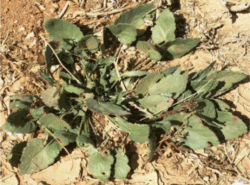
Schismus barbatus (L.) Thell. (Medicinal plant) Poaceae (Gramineae).
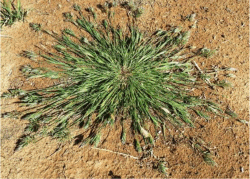
Althaea ludwigii L. (Medicinal plant) Malvaceae

Plantago lanceolata L. (Medicinal plant) Plantaginaceae

Reseda muricata C.Presl (Medicinal plant) Resedaceae
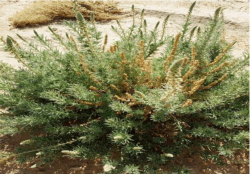
Hyoscyamus muticus L. (Medicinal plant) Solanaceae

Solanum americanum Mill.(= S. nigrum L.) (Medicinal plant) Solanaceae
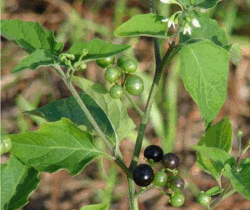
Ducrosia anethifolia (DC.) Boiss. (Medicinal plant) Apiaceae (Umbelliferae).
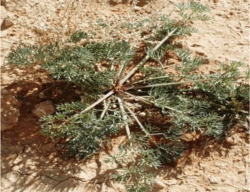
Tribulus terrestris L. (Medicinal plant) Zygophyllaceae
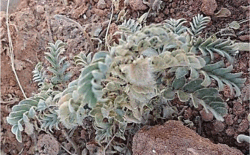
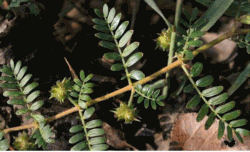
Disclosure statement
No potential conflict of interest was reported by the authors.
ORCID
Mohamed Abd El-Hameid Abdein http://orcid.org/0000-0001-8922-6089
Additional information
Funding
References
- Zahran M. Vegetation types of Saudi Arabia. Jeddah: King Abdel Aziz University Press; 1982.
- Miller AG, Cope TA. Flora of the Arabian Peninsula and Socotra. Edinburgh: Edinburgh University Press; 1996; 1: 1–30.
- Al-Shareef AS. Geography of Saudi Arabia. Riyadh: Dar AlMareekh; 2002.
- Zohary M. Geobotanical foundation of the Middle East. 2 Vols. Stuttgart: Gutav Fischer Verlag; 1973.
- Migahid AM. Flora of Saudi Arabia vols 1 & 2. Riyadh: Riyadh University; 1978.
- Migahid AM. Flora of Saudi Arabia. 3rd ed., Vols 1, 2 & 3. Riyadh: King Saud University Press; 1988–1990.
- Chaudhary SA. Flora of the Kingdom of Saudi Arabia. Vol. 1. Riyadh: Ministry of Agriculture and Water, National Herbarium, National Agriculture and Water Research Center; 1999. 691p.-illus. En Icones, Anatomy and morphology, Keys. Geog., 2.
- Chaudhary SA. Flora of the Kingdom of Saudi Arabia: illustrated volume 2 (part 3). Riyadh: Ministry of Agriculture iii; 2000. 432 p.-illus. En Icones, Anatomy and morphology, Keys, 2.
- Collenette S. Wild flowers of Saudi Arabia. King of Saudi Arabia: National Commission for Wild Life Conservation and Development (NCWCD) & Sheila Collenette. Kingdom of Saudi Arabia: King Fahd National Library; 1999, 220.
- Osman AK, Al-Ghamdi F, Bawadekji A. Floristic diversity and vegetation analysis of Wadi Arar: a typical desert Wadi of the Northern Border region of Saudi Arabia. Saudi J Biol Sci. 2014;21:554–565. doi: 10.1016/j.sjbs.2014.02.001
- Al-Farhan AH. An evaluation of the current status of the flora of Saudi Arabia. In Country report presented at the 2nd Arabian plants subject group meeting, Abu Dhabi; 2000.
- Alatar A, El-Sheikh MA, Thomas J. Vegetation analysis of Wadi Al-Jufair, a hyper-arid region in Najd, Saudi Arabia. Saudi J Biol Sci 2012;19:357–368. doi: 10.1016/j.sjbs.2012.04.003
- Al-Farhan A, Al-Turki TA, Basahy RA. Flora of Jizan Region, Final Report of project AR-17-7. King Abdulaziz City for Science and Technology (KACST), KSA, 1: 1-545; 2005.
- Thomas J. Onward (continuously updated). Plant diversity of Saudi Arabia, King Saud University; 2011 [cited 2013 March 12]. Available from: http://plantdiversityofsaudiarabia.info/Biodiversity-Saudi-Arabia/Flora/Checklist/Cheklist.htm
- Farraj HS. Floristic composition and vegetation-soil relationships in Wadi Al-Argy of Taif region, Saudi Arabia. Int Res J Plant Sci. 2012;3(8):147–157.
- Howladar SM. Chemical constituents of soil and vegetation of two stands in AL Baha area (Saudi Arabia). J Chem Pharm Res. 2014;6(3):1351–1355.
- El-Bana MI, Al-Mathnani A. Vegetation-soil relationships in the Wadi Al-Hayat area of the Libyan Sahara. Aust J Basic Appl Sci. 2009;3(2):740–747.
- Abdel-Fattah RI, Ali AA. Vegetation-environment relations in Taif, Saudi Arabia. Int J Botany. 2005;1:206–211. doi: 10.3923/ijb.2005.206.211
- Al-Huquial A, Al-Turki TA. Ecological studies on the natural vegetation at Sabkha Al-Aushaiza in Al-Gassim region, Saudi Arabia. Saudi J Biol Sci. 2006;13:79–110.
- Al-Khamis HH, Al-Hemaid FM, Ibrahim ASS. Diversity of perennial plants at ibex reserve in Saudi Arabia. J Anim Plant Sci. 2012;22(2):484–492.
- Cope T. (1985). A key to the grasses of Arabian Peninsula. Arabian Journal Science Research, Special Publication.
- Chaudhary SA. Flora of the Kingdom of Saudi Arabia. Vols. 1–3. Riyadh: Ministry of Agriculture and Water Press; 1999–2001.
- Täckholm V. Students’ Flora of Egypt. Cairo Unvi., printed by Cooperative Printing Company Beirut; 1974. p. 888.
- Boulos L. Flora of Egypt. Vol. I (Azollaceae-Oxalidaceae). Cairo: A1-Hadara Publishing; 1999. p. 419.
- Boulos L. Flora of Egypt. Vol. II (Geraniaceae-Boraginaceae). Cairo: A1-Hadara Publishing: 2000. p. 352.
- Boulos L. Flora of Egypt. Vol. III (Verbenaceae-Asteraceae). Cairo: A1-Hadara Publishing: 2002. p. 373.
- Boulos L. Flora of Egypt. Vol. IV Monocotyledons (Alismataceae-Orchidaceae). Cairo: A1-Hadara Publishing; 2005. p. 617.
- Boulos L. Flora of Egypt checklist (revised annotated ed.). Cairo: Al-Hadara Publishing; 2009. p. 410.
- Raunkiaer C. The plant life forms and statistical plant geography. Oxford: Clarendon Press; 1934. p. 632.
- Govaerts R, Frodin DG, Radcliffe-Smith A, Carter S. World checklist and bibliography of Euphorbiaceae (with Pandaceae). Kew: Royal Botanic Gardens; 2000. p. 1621.
- Eig A. Les elements et les groups phytogeogra-phique auxiliaries dans la florepalestiniene. Feddes Repert. 1931;63:470–496.
- Farrag HF. Floristic composition and vegetation-soil relationships in Wadi Al-Argy of Taif region, Saudi Arabia. Int Res J Plant Sci. 2012;3(8):147–157.
- Aldhebiani AY, Howladar SM. Floristic diversity and environmental relations in two valleys, South West Saudi Arabia. Int J Sci Res. 2013;4(2):1916–1925.
- Seraj SS, Jrais RN, Ayyad SK. Floristic composition, life form and Chorology of plant life at Al-Saoda, Asir region, South-Western Saudi Arabia. J Biol Agric Healthcare. 2014;4(26):60–65.
- Al-Turki TA, Al-Qlayan HA. Contribution to the flora of Saudi Arabia: Hail region. Saudi J Biol Sci. 2003;10:190–222.
- El-Ghanim WA, Hassan LM, Galal TM, et al. Floristic composition and vegetation analysis in Hail region north of central Saudi Arabia. Saudi J Biol Sci. 2010;17:119–128. doi: 10.1016/j.sjbs.2010.02.004
- Abdel Khalik KA, El-Sheikh M, El-Aidarous A. Floristic diversity and vegetation analysis of wadi Al-Noman, Mecca, Saudi Arabia. Turk J Bot. 2013;37(5):894–907. doi: 10.3906/bot-1209-56
- Al-Nafie A. Phytogeography of Saudi Arabia. Saudi J Biol Sci. 2008;15(1):159–176.
- Good R. The geography of the flowering plants. 4th ed. London: Longman Group Limited; 1974. p. 557.
- Al-Sherif EA, Ayesh AM, Rawi SM. Floristic composition, life form and chorology of plant life at Khulais region, Western Saudi Arabia. Pak J Bot. 2013;45(1):29–38.
- Shaltout KH, El-Halawany EF, El-Kady HF. Consequences of protection from grazing on diversity and abundance of the coastal lowland vegetation in eastern Saudi Arabia. Biodivers Conserv. 1996;5:27–36. doi: 10.1007/BF00056290
- Al-Rowaily SL, El-Bana MI, Al-Dujain FA. Changes in vegetation composition and diversity in relation to morphometry, soil and grazing on a hyper-arid watershed in the central Saudi Arabia. Catena. 2012;97:41–49. doi: 10.1016/j.catena.2012.05.004
- Orshan G. The desert of the Middle East. In: Evenari M, Noy-Meir I, Goodall DW, editors. Ecosystems of the world. Vol. 12B. Amsterdam: Elsevier; 1986. p. 1–28.
- Shaltout KH, Sheded MG, Salem AM. Vegetation spatial heterogeneity in a hyper arid biosphere reserve area in North Africa. Acta Botanica Croatia. 2010;69:31–46.
- El-Demerdash MA, Hegazy AK, Zilay MA. Vegetation-soil relationships in Tihamah coastal plains of Jazan region, Saudi Arabia. J Arid Environ. 1995;30:161–174. doi: 10.1016/S0140-1963(05)80067-9
- Fahmy AG, Hassan LM. Plant diversity of Wadi el Ghayl, Aseer Mountains, Saudi Arabia. Egypt J Desert Res. 2005;55:39–52.
- Mosallam HAM. Comparative study on the vegetation of fenced and non-fenced areas, Sudera, Taif, Saudi Arabia. Int J Agric Biol. 2007;9(2):202–214.
- Salman AA. Correlation between plant distribution and edaphic factors in coastal plains of Jazan region, Saudi Arabia. J Appl Biol Biotechnol. 2015;3(03):042–049.
- Cain SA. Life-forms and phytoclimate. Bot Rev. 1950;16:1–32. doi: 10.1007/BF02879783
- Deschenes JM. Life form spectra of contrasting slops of the grazed pastures of Northern New Jersey. Neturalise Can. 1969;96:965–978.
- Barbero M, Bonin G, Loisel R, et al. Changes and disturbances of forest ecosystems caused by human activities in the western part of the Mediterranean basin. Vegetatio. 1990;87:151–173. doi: 10.1007/BF00042952
- Danin A, Plitman U. Revision of the plant geographical territories of Israel and Sinai. Plant Syst Evol. 1987;156:43–53. doi: 10.1007/BF00937200
- Abd El-Ghani M, Amer WM. Soil-vegetation relationships in a coastal desert plain of southern Sinai, Egypt. J Arid Environ. 2003:55:607–628. doi: 10.1016/S0140-1963(02)00318-X

